Ind vs Eng, 5th Test: New Dukes ball doesn’t swing much, lacquer goes off early, gets softer and makes scoring easy in the middle overs.
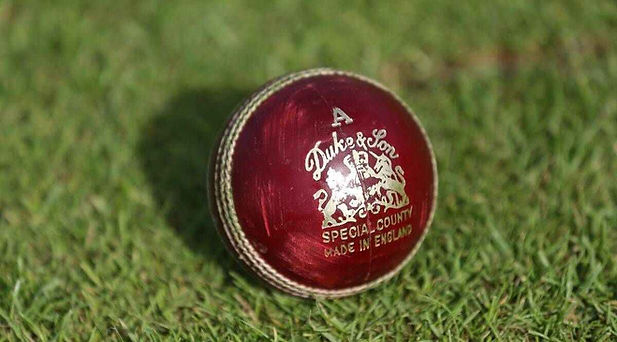
It was the fifth day of the rescheduled Test match between England and India at Edgbaston in Birmingham, when the umpires in the first 40-odd minutes had to change the ball almost five times because it failed to go through the ring test. It has been a trend this summer with the balls, starting from the county games to the international matches.
There are couple of main reasons that appear to be creating issues; first, the lacquer or the seam of Dukes ball gets diminished speedily in almost 40-45 overs which decreases swing and secondly, it’s getting softer which erases out the reverse swing, making run-scoring a bit easier.
SG, Dukes, Kookaburra – Three types of balls in different regions
There are various balls that are being used in international Test cricket across countries by different manufacturers. Sanspareils Greenlands (SG) is a company that manufactures the ball that is used in India for both international cricket and Ranji Trophy.
Kookaburra Sport is an Australian sports equipment company that manufactures the Kookaburra brand of ball which is used in Test matches in Australia, New Zealand, South Africa, Pakistan, Sri Lanka and Zimbabwe.
The third and final one is the Dukes balls which is used in Test cricket in England, West Indies and Ireland.
Read More: Eng vs Ind, 5th Test, Top Performances: Root, Bairstow tons help Eng complete 8th highest chase

Quality erosion of Dukes ball
Dukes ball seemed to lose its shape quite often this season. England’s prime pacer, Stuart Broad has compared it to “rolled-up plasticine” whereas the commentators too have displayed their concern on its standard.
During the England-New Zealand Test series this summer, Kane Williamson and his men repeatedly kept complaining to the umpires about changing the ball during the course of the games. In fact, in a county game between Durham and Glamorgan this year, the ball had to be changed about 11 times, including five in just one day.
“They have not swung and because they are going soft very quickly, neither is there any bounce,” Broad who played a few games for Nottinghamshire earlier in this season, examined in his column.
“It has felt like bowling with a rolled-up piece of plasticine and the balls are that soft you feel like you can squeeze them even before you have bowled a ball with them.”
“This is not a machine-engineered product”- Jajodia about Dukes ball
In an interview with the Indian Express, Dilip Jajodia, owner of the company that manufactures the Dukes ball, suspects that it’s occurring due to issues in the tanning process; however, he too is yet to identify the definite cause of the ball’s tendency of losing shape during the course of a game.
“My guess is that there’s some technical problem in the process of tanning which goes back months,” Jajodia told Indian Express.
“This is not a machine-engineered product, this is a hand-made, crafted product. If a problem occurs, you have to live with it.”
Talking about the player’s dissatisfaction, Dilip reacted in a scratchy way. “When you notice, it’s always when they aren’t getting wickets; now it has become a standard practice.”
Jajodia, at the end of the interview, suggested that there should a limitation on the number of appeals players could do to the umpires on changing the ball.
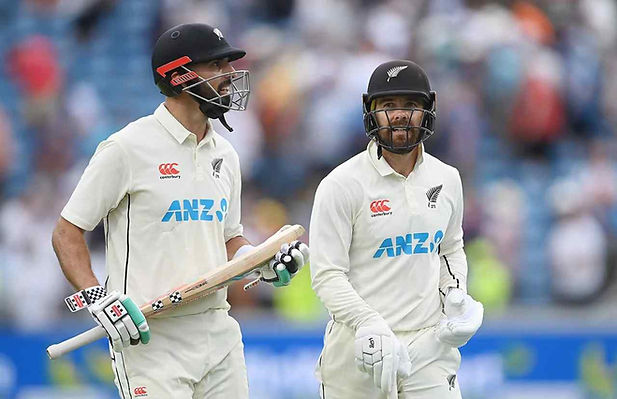
Read More: Architects in White: 90 years, 9 Test wins & 3 Test series wins for India in England
“Players have gotten smarter around the balls being changed frequently.”- Giles
Ashley Giles, former England Cricket Board (ECB) managing director, in an interview, has discussed how players have often begun to worry on the ball as soon as they are not getting wickets. “Players have gotten smarter around the ball being changed frequently,” Giles expressed in an interview with ESPNCricinfo.
“It has become a very common ploy in the modern game,” he added.
Wasim Jaffer, who was part of Team India that defeated England on their soil in a Test series the last time in 2007, has also moved in the same direction. “That’s been the pattern in the whole summer, teams get five down quickly and then there is a big partnership and the same trend has been pretty similar in this Test (England vs India) as well.”
Let’s scan a few of these events where batters in the middle-order have had a pleasant stay on the pitch.
From Mitchell-Blundell partnerhip to Bairstow-Overton stand in England-New Zealand series
It was really comfortable for the new ball bowlers from both sides to make inroads at the top before finding themselves in all sorts of trouble facing the middle-order.
During the England-New Zealand series, wickets fell at the top quite easily until the middle-order stitched up huge stands between them. In the second innings of Lord’s Test, England reduced the Blackcaps to 56/4 before Daryl Mitchell and Tom Blundell registered a stunning 195-run stand for the fifth wicket.
In the very next Test at Trent Bridge in Nottingham, New Zealand were under a bit of pressure losing couple of quick wickets. But again, the world saw a 236-run partnership between the same pair to propel the World Test champions from 169/4 to 405/5. It hasn’t finished yet!
In the next Test match at Leeds in Headingley, the same set of players sewed up 120 and 113-run stands in the first and second innings, respectively, for the sixth wicket. At the end of the series, the Mitchell-Blundell partnership scored 724 runs in partnerships which is their team’s highest during a Test series.
Also, they faced 23 per cent of the deliveries in that series, which was the most for any pair in a series comprising a minimum of three games.
The same fact can be told about England; they too have lost wickets at the top but have recovered tremendously thanks to their middle-order. Especially, during the third Test in Headingley, they were limping at 55/6 before getting entertained with a 241-run stand in about 45.4 overs between Jonny Bairstow and debutant Jamie Overton.
The numbers spell out that the middle-order (4-7) of New Zealand has scored 60.18 per cent of runs while their top order (1-3) struggled in gathering 23.46 per cent of runs. On the flipside of the coin, England’s top order (1-3) collected just 27.32 per cent of runs, while their middle-order (4-7) smashed 57 per cent of the total runs scored by their team.
Read More: Eng vs Ind, 5th Test, Day 3, Top Performances: Bairstow shines with 106; India 257 runs ahead
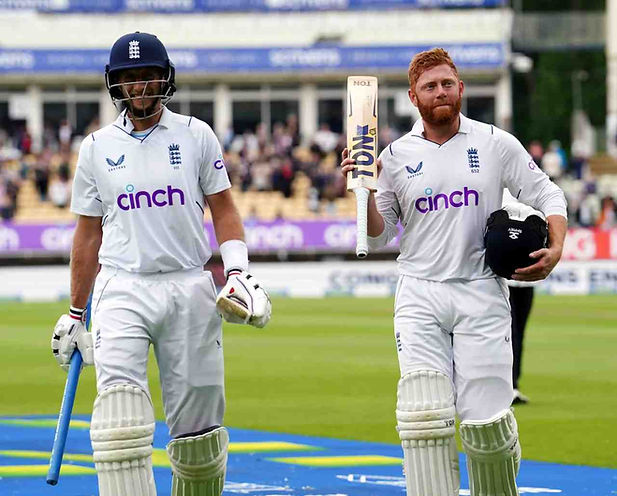
Pant-Jadeja to Bairstow-Root: The same story for England-India series
The tagline was same even for the rescheduled Test between England and India at Edgbaston in Birmingham. The visitors were wrestling at 98/5 losing their top-order before Rishabh Pant and Ravindra Jadeja partnered for 222 runs where both of them notched up their respective centuries. There is no doubt about their skills and ability to score those runs but the softness of the ball did make it little easier for them.
The hosts too lost half of their side with just 83 runs on the board but ended up with 284 runs which meant that 71 per cent of those runs had come from the last five wickets where Jonny Bairstow, with his fabulous 106 in just 140 balls, made a huge contribution.
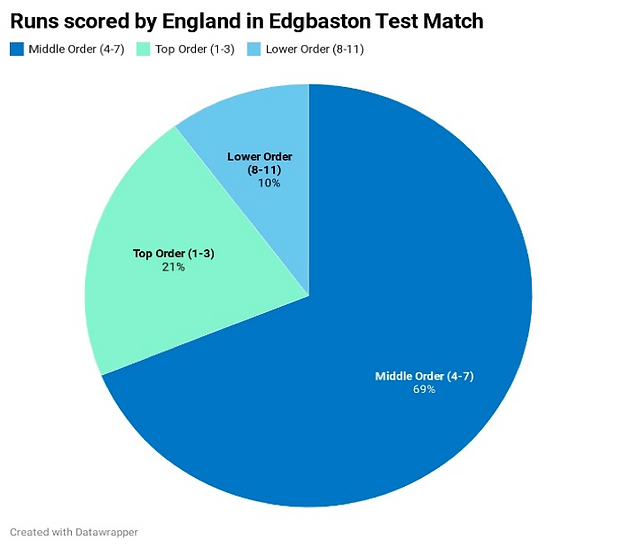
Hence, in the Edgbaston Test, England’s middle-order (4-7) piled 69 per cent of the runs while the number was just 21 per cent as far as the top-order (1-3) was concerned. On the other hand, India, whose last five wickets scored 76 per cent of runs in their first innings, saw their middle-order (4-7) scoring 66 per cent of runs compared to 22 per cent scored by their top-order (1-3).
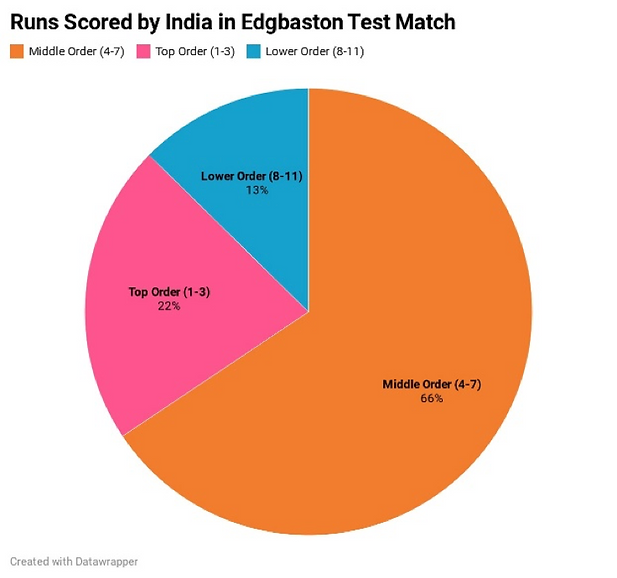
Substantial advantage for the middle-order
There is nothing to take away from the expertise of the batters in the middle-order but there is a sort of advantage they were at because of the old ball that lost its movement and denied reverse swing.
There was an instance when on the fourth day in the Test between England and India, Virat Kohli was batting quite easily in the middle before there was a change of ball. Just two overs later, Kohli received a peach of a delivery that bounced awkwardly to take the edge of Kohli’s gloves and died in the hands of first slip.
So, it’s expected that the England Cricket Board (ECB) take a look into the matter to make it an even contest. Test cricket should be result-oriented but the game should not be in the batters’ court only. Afterall, it’s an exciting game between bat and ball.
Read More: Eng vs Ind, Edgbaston Test 2022: Vihari, Iyer disappoint; Shardul, Jadeja found wanting with ball

